Examining Cultural Safety and Capabilities: A Comprehensive Report
VerifiedAdded on 2023/06/04
|8
|2313
|136
Report
AI Summary
This report analyzes a video scenario through the lens of cultural intelligence, safety, and capabilities, focusing on the dynamics between characters in a workplace setting. It identifies the scenario as culturally unsafe due to instances of cultural unintelligence and a lack of cultural capabilities displayed by one of the characters. The report delves into the importance of respecting social and cultural differences to foster a safe environment and emphasizes the need for emotional control and understanding in social interactions. Furthermore, the report provides recommendations for improving cultural safety in similar environments, advocating for ethical behavior, motivation of subordinates, and the importance of addressing and overcoming criticisms. The analysis concludes that creating a safe social place is the responsibility of every member of an organization, requiring both supervisors and subordinates to actively promote diversity and inclusion while rejecting cultural maltreatment.
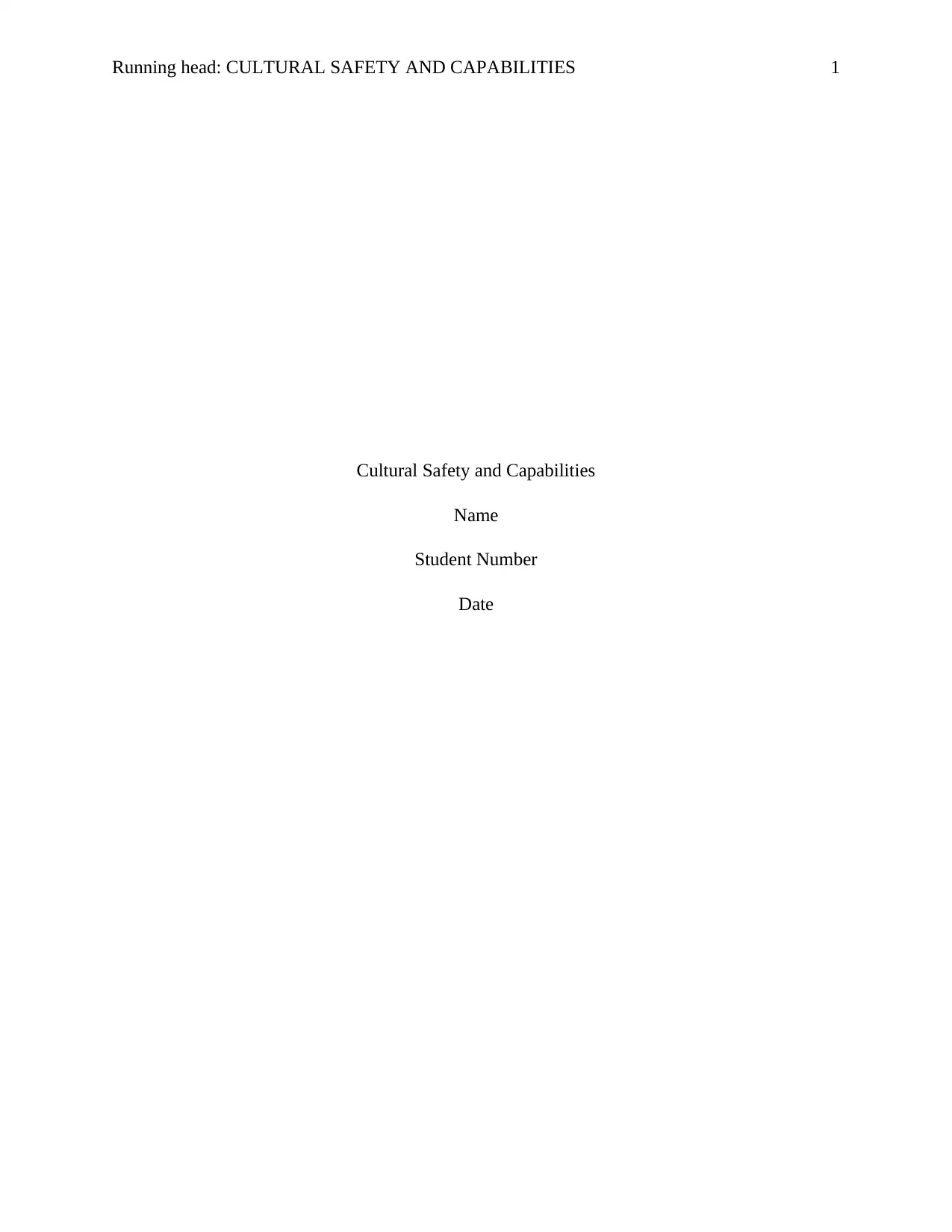
Running head: CULTURAL SAFETY AND CAPABILITIES 1
Cultural Safety and Capabilities
Name
Student Number
Date
Cultural Safety and Capabilities
Name
Student Number
Date
Paraphrase This Document
Need a fresh take? Get an instant paraphrase of this document with our AI Paraphraser
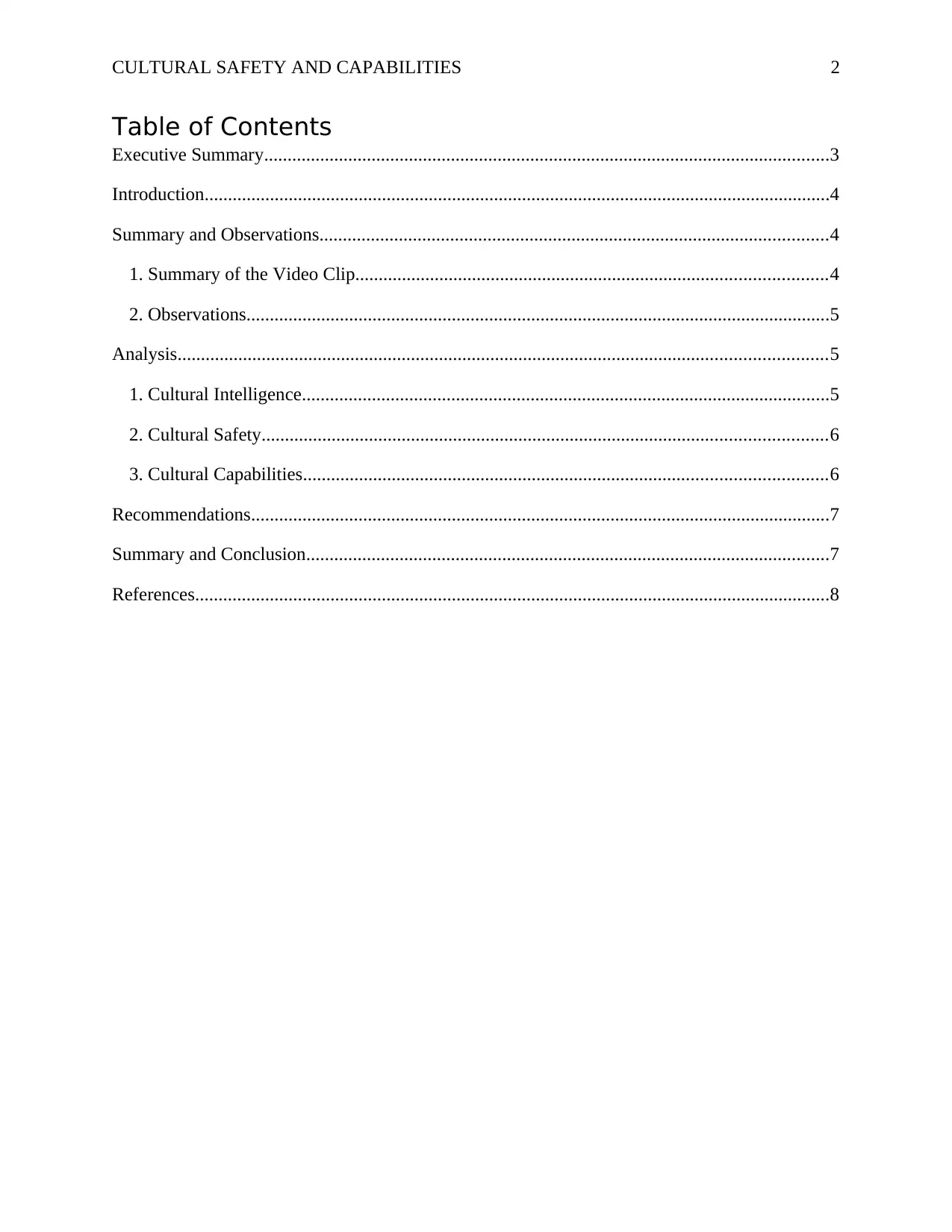
CULTURAL SAFETY AND CAPABILITIES 2
Table of Contents
Executive Summary.........................................................................................................................3
Introduction......................................................................................................................................4
Summary and Observations.............................................................................................................4
1. Summary of the Video Clip.....................................................................................................4
2. Observations.............................................................................................................................5
Analysis...........................................................................................................................................5
1. Cultural Intelligence.................................................................................................................5
2. Cultural Safety.........................................................................................................................6
3. Cultural Capabilities................................................................................................................6
Recommendations............................................................................................................................7
Summary and Conclusion................................................................................................................7
References........................................................................................................................................8
Table of Contents
Executive Summary.........................................................................................................................3
Introduction......................................................................................................................................4
Summary and Observations.............................................................................................................4
1. Summary of the Video Clip.....................................................................................................4
2. Observations.............................................................................................................................5
Analysis...........................................................................................................................................5
1. Cultural Intelligence.................................................................................................................5
2. Cultural Safety.........................................................................................................................6
3. Cultural Capabilities................................................................................................................6
Recommendations............................................................................................................................7
Summary and Conclusion................................................................................................................7
References........................................................................................................................................8
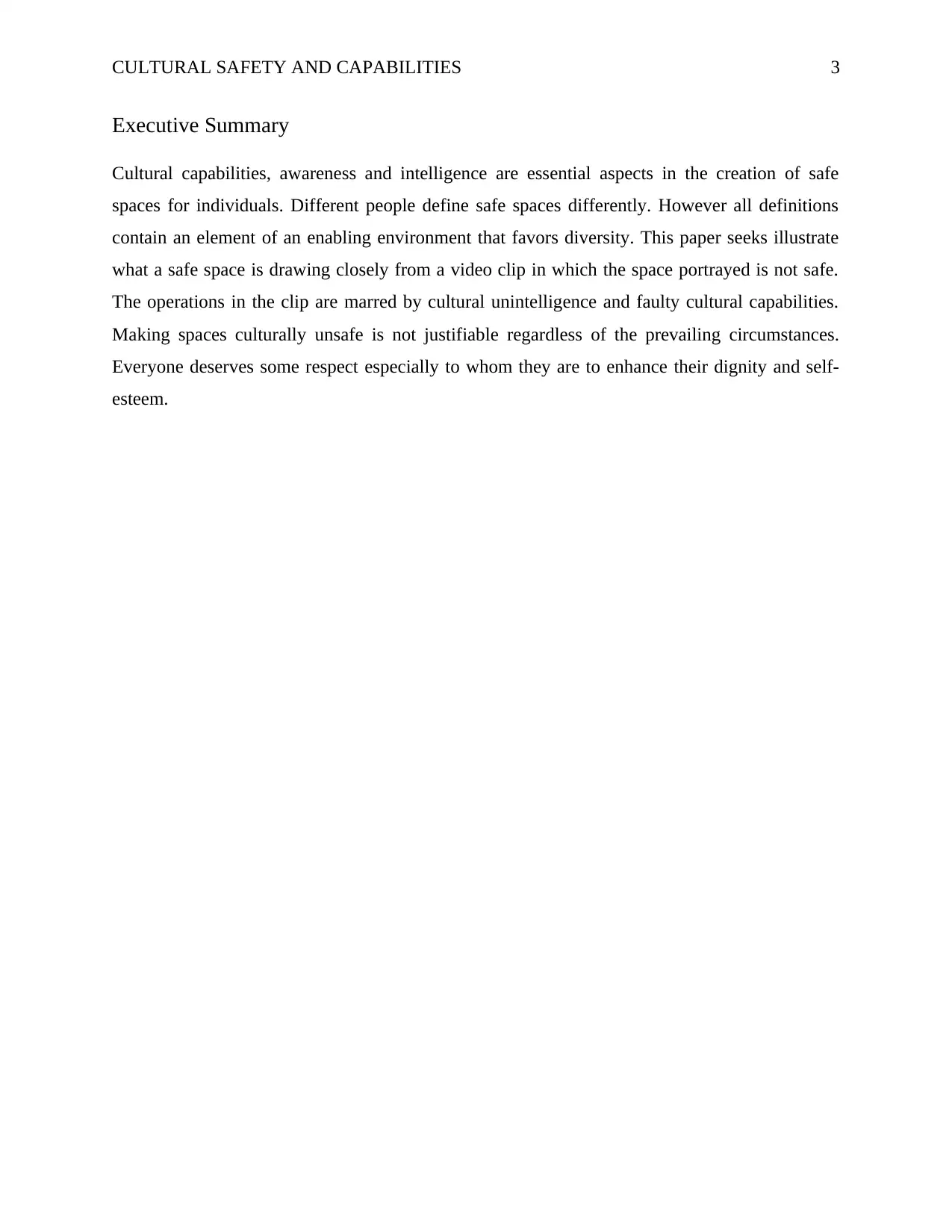
CULTURAL SAFETY AND CAPABILITIES 3
Executive Summary
Cultural capabilities, awareness and intelligence are essential aspects in the creation of safe
spaces for individuals. Different people define safe spaces differently. However all definitions
contain an element of an enabling environment that favors diversity. This paper seeks illustrate
what a safe space is drawing closely from a video clip in which the space portrayed is not safe.
The operations in the clip are marred by cultural unintelligence and faulty cultural capabilities.
Making spaces culturally unsafe is not justifiable regardless of the prevailing circumstances.
Everyone deserves some respect especially to whom they are to enhance their dignity and self-
esteem.
Executive Summary
Cultural capabilities, awareness and intelligence are essential aspects in the creation of safe
spaces for individuals. Different people define safe spaces differently. However all definitions
contain an element of an enabling environment that favors diversity. This paper seeks illustrate
what a safe space is drawing closely from a video clip in which the space portrayed is not safe.
The operations in the clip are marred by cultural unintelligence and faulty cultural capabilities.
Making spaces culturally unsafe is not justifiable regardless of the prevailing circumstances.
Everyone deserves some respect especially to whom they are to enhance their dignity and self-
esteem.
⊘ This is a preview!⊘
Do you want full access?
Subscribe today to unlock all pages.

Trusted by 1+ million students worldwide
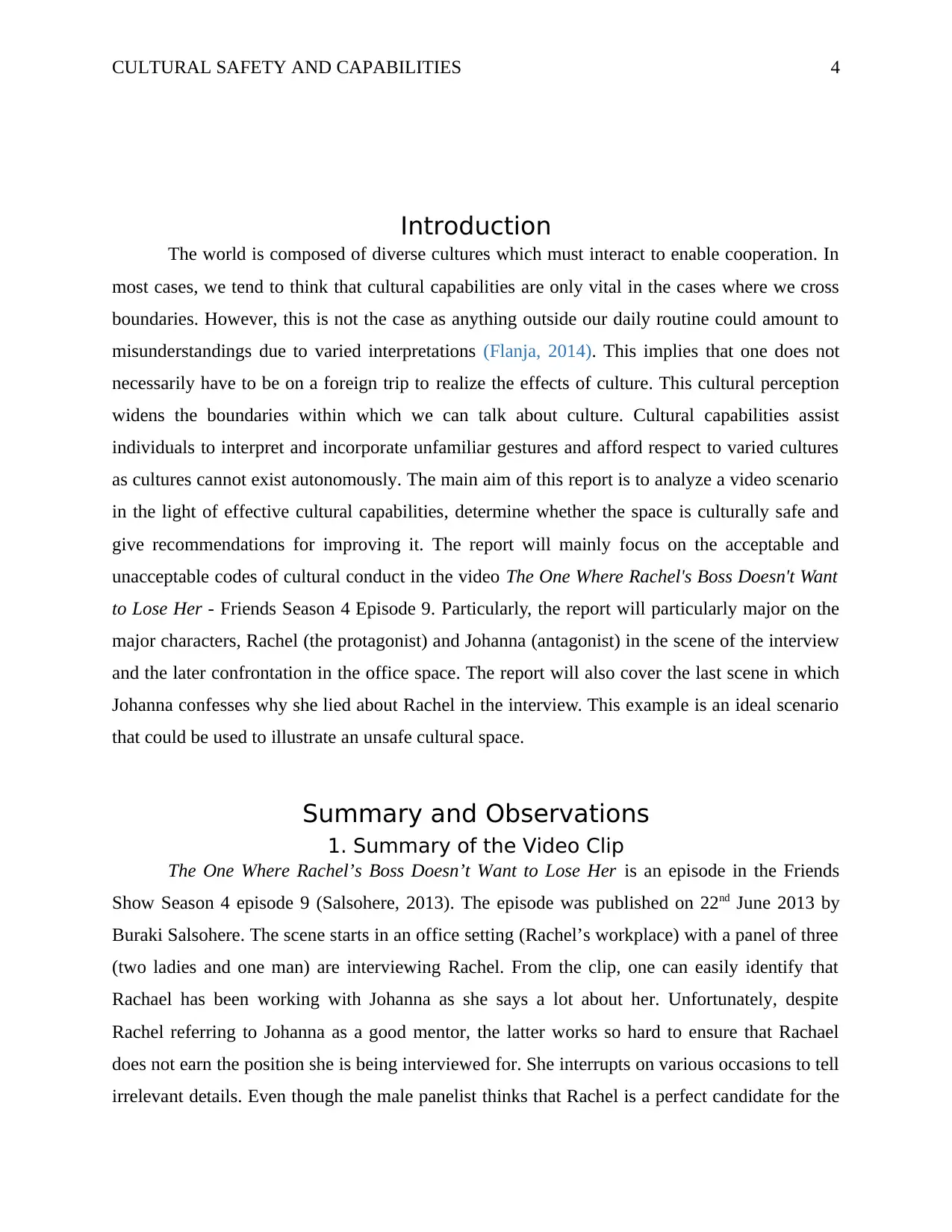
CULTURAL SAFETY AND CAPABILITIES 4
Introduction
The world is composed of diverse cultures which must interact to enable cooperation. In
most cases, we tend to think that cultural capabilities are only vital in the cases where we cross
boundaries. However, this is not the case as anything outside our daily routine could amount to
misunderstandings due to varied interpretations (Flanja, 2014). This implies that one does not
necessarily have to be on a foreign trip to realize the effects of culture. This cultural perception
widens the boundaries within which we can talk about culture. Cultural capabilities assist
individuals to interpret and incorporate unfamiliar gestures and afford respect to varied cultures
as cultures cannot exist autonomously. The main aim of this report is to analyze a video scenario
in the light of effective cultural capabilities, determine whether the space is culturally safe and
give recommendations for improving it. The report will mainly focus on the acceptable and
unacceptable codes of cultural conduct in the video The One Where Rachel's Boss Doesn't Want
to Lose Her - Friends Season 4 Episode 9. Particularly, the report will particularly major on the
major characters, Rachel (the protagonist) and Johanna (antagonist) in the scene of the interview
and the later confrontation in the office space. The report will also cover the last scene in which
Johanna confesses why she lied about Rachel in the interview. This example is an ideal scenario
that could be used to illustrate an unsafe cultural space.
Summary and Observations
1. Summary of the Video Clip
The One Where Rachel’s Boss Doesn’t Want to Lose Her is an episode in the Friends
Show Season 4 episode 9 (Salsohere, 2013). The episode was published on 22nd June 2013 by
Buraki Salsohere. The scene starts in an office setting (Rachel’s workplace) with a panel of three
(two ladies and one man) are interviewing Rachel. From the clip, one can easily identify that
Rachael has been working with Johanna as she says a lot about her. Unfortunately, despite
Rachel referring to Johanna as a good mentor, the latter works so hard to ensure that Rachael
does not earn the position she is being interviewed for. She interrupts on various occasions to tell
irrelevant details. Even though the male panelist thinks that Rachel is a perfect candidate for the
Introduction
The world is composed of diverse cultures which must interact to enable cooperation. In
most cases, we tend to think that cultural capabilities are only vital in the cases where we cross
boundaries. However, this is not the case as anything outside our daily routine could amount to
misunderstandings due to varied interpretations (Flanja, 2014). This implies that one does not
necessarily have to be on a foreign trip to realize the effects of culture. This cultural perception
widens the boundaries within which we can talk about culture. Cultural capabilities assist
individuals to interpret and incorporate unfamiliar gestures and afford respect to varied cultures
as cultures cannot exist autonomously. The main aim of this report is to analyze a video scenario
in the light of effective cultural capabilities, determine whether the space is culturally safe and
give recommendations for improving it. The report will mainly focus on the acceptable and
unacceptable codes of cultural conduct in the video The One Where Rachel's Boss Doesn't Want
to Lose Her - Friends Season 4 Episode 9. Particularly, the report will particularly major on the
major characters, Rachel (the protagonist) and Johanna (antagonist) in the scene of the interview
and the later confrontation in the office space. The report will also cover the last scene in which
Johanna confesses why she lied about Rachel in the interview. This example is an ideal scenario
that could be used to illustrate an unsafe cultural space.
Summary and Observations
1. Summary of the Video Clip
The One Where Rachel’s Boss Doesn’t Want to Lose Her is an episode in the Friends
Show Season 4 episode 9 (Salsohere, 2013). The episode was published on 22nd June 2013 by
Buraki Salsohere. The scene starts in an office setting (Rachel’s workplace) with a panel of three
(two ladies and one man) are interviewing Rachel. From the clip, one can easily identify that
Rachael has been working with Johanna as she says a lot about her. Unfortunately, despite
Rachel referring to Johanna as a good mentor, the latter works so hard to ensure that Rachael
does not earn the position she is being interviewed for. She interrupts on various occasions to tell
irrelevant details. Even though the male panelist thinks that Rachel is a perfect candidate for the
Paraphrase This Document
Need a fresh take? Get an instant paraphrase of this document with our AI Paraphraser
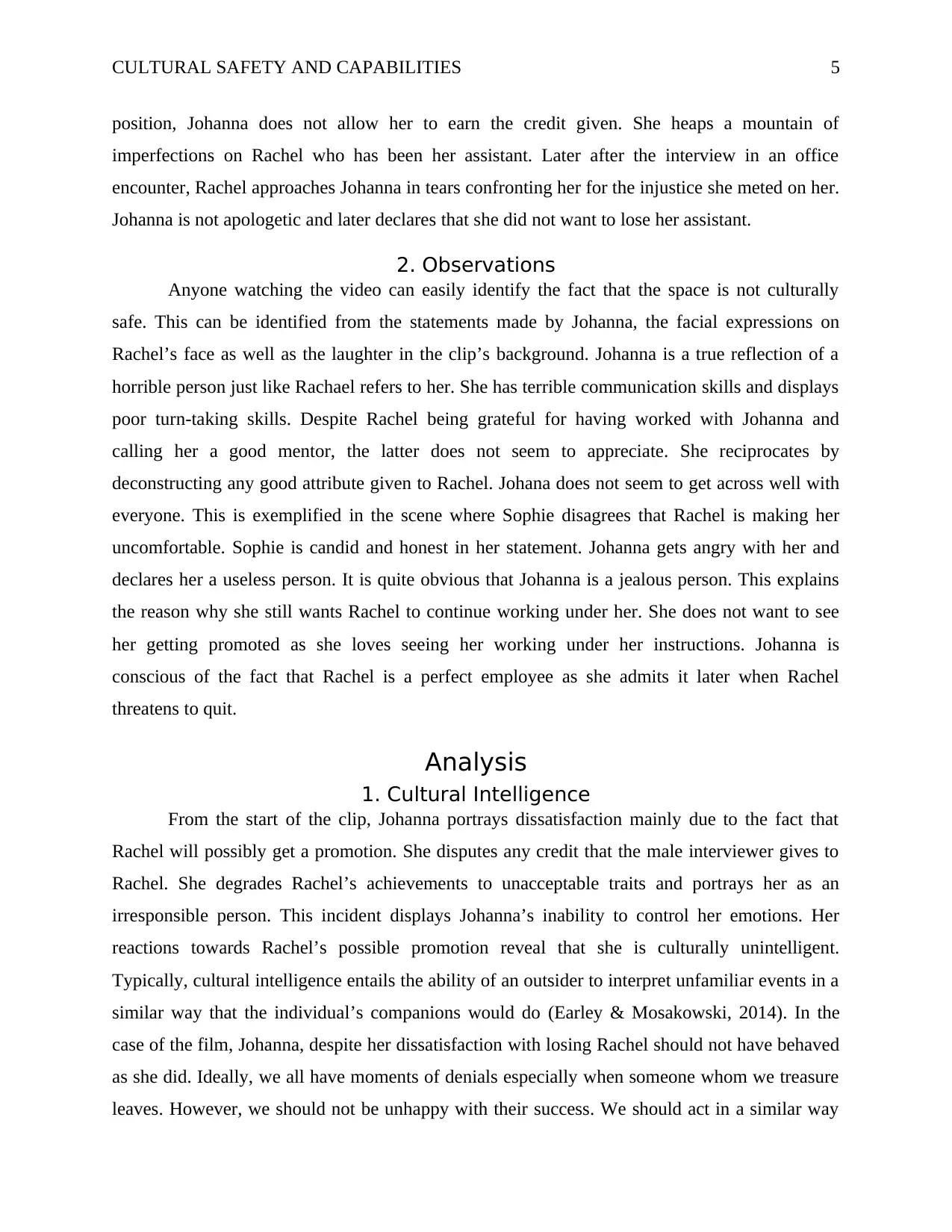
CULTURAL SAFETY AND CAPABILITIES 5
position, Johanna does not allow her to earn the credit given. She heaps a mountain of
imperfections on Rachel who has been her assistant. Later after the interview in an office
encounter, Rachel approaches Johanna in tears confronting her for the injustice she meted on her.
Johanna is not apologetic and later declares that she did not want to lose her assistant.
2. Observations
Anyone watching the video can easily identify the fact that the space is not culturally
safe. This can be identified from the statements made by Johanna, the facial expressions on
Rachel’s face as well as the laughter in the clip’s background. Johanna is a true reflection of a
horrible person just like Rachael refers to her. She has terrible communication skills and displays
poor turn-taking skills. Despite Rachel being grateful for having worked with Johanna and
calling her a good mentor, the latter does not seem to appreciate. She reciprocates by
deconstructing any good attribute given to Rachel. Johana does not seem to get across well with
everyone. This is exemplified in the scene where Sophie disagrees that Rachel is making her
uncomfortable. Sophie is candid and honest in her statement. Johanna gets angry with her and
declares her a useless person. It is quite obvious that Johanna is a jealous person. This explains
the reason why she still wants Rachel to continue working under her. She does not want to see
her getting promoted as she loves seeing her working under her instructions. Johanna is
conscious of the fact that Rachel is a perfect employee as she admits it later when Rachel
threatens to quit.
Analysis
1. Cultural Intelligence
From the start of the clip, Johanna portrays dissatisfaction mainly due to the fact that
Rachel will possibly get a promotion. She disputes any credit that the male interviewer gives to
Rachel. She degrades Rachel’s achievements to unacceptable traits and portrays her as an
irresponsible person. This incident displays Johanna’s inability to control her emotions. Her
reactions towards Rachel’s possible promotion reveal that she is culturally unintelligent.
Typically, cultural intelligence entails the ability of an outsider to interpret unfamiliar events in a
similar way that the individual’s companions would do (Earley & Mosakowski, 2014). In the
case of the film, Johanna, despite her dissatisfaction with losing Rachel should not have behaved
as she did. Ideally, we all have moments of denials especially when someone whom we treasure
leaves. However, we should not be unhappy with their success. We should act in a similar way
position, Johanna does not allow her to earn the credit given. She heaps a mountain of
imperfections on Rachel who has been her assistant. Later after the interview in an office
encounter, Rachel approaches Johanna in tears confronting her for the injustice she meted on her.
Johanna is not apologetic and later declares that she did not want to lose her assistant.
2. Observations
Anyone watching the video can easily identify the fact that the space is not culturally
safe. This can be identified from the statements made by Johanna, the facial expressions on
Rachel’s face as well as the laughter in the clip’s background. Johanna is a true reflection of a
horrible person just like Rachael refers to her. She has terrible communication skills and displays
poor turn-taking skills. Despite Rachel being grateful for having worked with Johanna and
calling her a good mentor, the latter does not seem to appreciate. She reciprocates by
deconstructing any good attribute given to Rachel. Johana does not seem to get across well with
everyone. This is exemplified in the scene where Sophie disagrees that Rachel is making her
uncomfortable. Sophie is candid and honest in her statement. Johanna gets angry with her and
declares her a useless person. It is quite obvious that Johanna is a jealous person. This explains
the reason why she still wants Rachel to continue working under her. She does not want to see
her getting promoted as she loves seeing her working under her instructions. Johanna is
conscious of the fact that Rachel is a perfect employee as she admits it later when Rachel
threatens to quit.
Analysis
1. Cultural Intelligence
From the start of the clip, Johanna portrays dissatisfaction mainly due to the fact that
Rachel will possibly get a promotion. She disputes any credit that the male interviewer gives to
Rachel. She degrades Rachel’s achievements to unacceptable traits and portrays her as an
irresponsible person. This incident displays Johanna’s inability to control her emotions. Her
reactions towards Rachel’s possible promotion reveal that she is culturally unintelligent.
Typically, cultural intelligence entails the ability of an outsider to interpret unfamiliar events in a
similar way that the individual’s companions would do (Earley & Mosakowski, 2014). In the
case of the film, Johanna, despite her dissatisfaction with losing Rachel should not have behaved
as she did. Ideally, we all have moments of denials especially when someone whom we treasure
leaves. However, we should not be unhappy with their success. We should act in a similar way
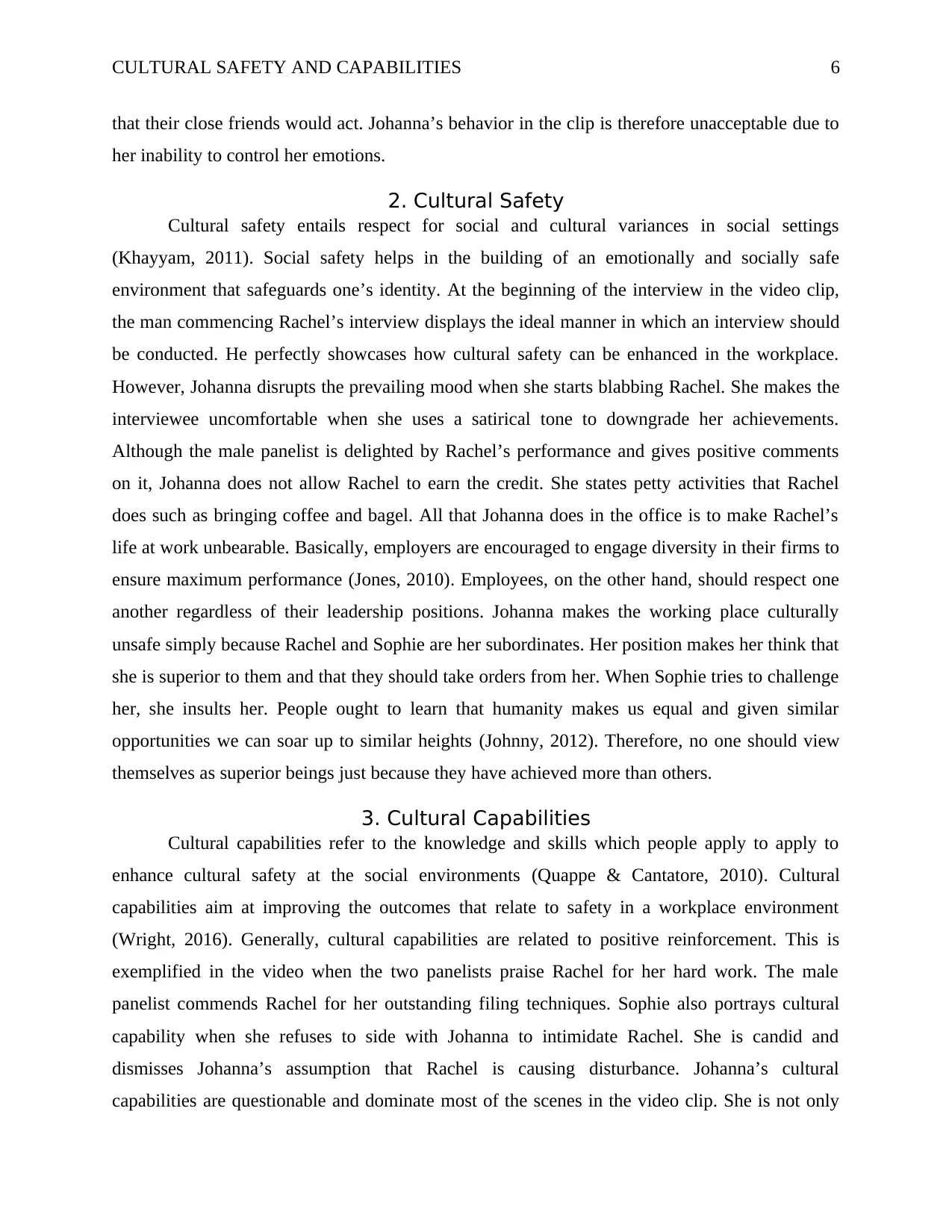
CULTURAL SAFETY AND CAPABILITIES 6
that their close friends would act. Johanna’s behavior in the clip is therefore unacceptable due to
her inability to control her emotions.
2. Cultural Safety
Cultural safety entails respect for social and cultural variances in social settings
(Khayyam, 2011). Social safety helps in the building of an emotionally and socially safe
environment that safeguards one’s identity. At the beginning of the interview in the video clip,
the man commencing Rachel’s interview displays the ideal manner in which an interview should
be conducted. He perfectly showcases how cultural safety can be enhanced in the workplace.
However, Johanna disrupts the prevailing mood when she starts blabbing Rachel. She makes the
interviewee uncomfortable when she uses a satirical tone to downgrade her achievements.
Although the male panelist is delighted by Rachel’s performance and gives positive comments
on it, Johanna does not allow Rachel to earn the credit. She states petty activities that Rachel
does such as bringing coffee and bagel. All that Johanna does in the office is to make Rachel’s
life at work unbearable. Basically, employers are encouraged to engage diversity in their firms to
ensure maximum performance (Jones, 2010). Employees, on the other hand, should respect one
another regardless of their leadership positions. Johanna makes the working place culturally
unsafe simply because Rachel and Sophie are her subordinates. Her position makes her think that
she is superior to them and that they should take orders from her. When Sophie tries to challenge
her, she insults her. People ought to learn that humanity makes us equal and given similar
opportunities we can soar up to similar heights (Johnny, 2012). Therefore, no one should view
themselves as superior beings just because they have achieved more than others.
3. Cultural Capabilities
Cultural capabilities refer to the knowledge and skills which people apply to apply to
enhance cultural safety at the social environments (Quappe & Cantatore, 2010). Cultural
capabilities aim at improving the outcomes that relate to safety in a workplace environment
(Wright, 2016). Generally, cultural capabilities are related to positive reinforcement. This is
exemplified in the video when the two panelists praise Rachel for her hard work. The male
panelist commends Rachel for her outstanding filing techniques. Sophie also portrays cultural
capability when she refuses to side with Johanna to intimidate Rachel. She is candid and
dismisses Johanna’s assumption that Rachel is causing disturbance. Johanna’s cultural
capabilities are questionable and dominate most of the scenes in the video clip. She is not only
that their close friends would act. Johanna’s behavior in the clip is therefore unacceptable due to
her inability to control her emotions.
2. Cultural Safety
Cultural safety entails respect for social and cultural variances in social settings
(Khayyam, 2011). Social safety helps in the building of an emotionally and socially safe
environment that safeguards one’s identity. At the beginning of the interview in the video clip,
the man commencing Rachel’s interview displays the ideal manner in which an interview should
be conducted. He perfectly showcases how cultural safety can be enhanced in the workplace.
However, Johanna disrupts the prevailing mood when she starts blabbing Rachel. She makes the
interviewee uncomfortable when she uses a satirical tone to downgrade her achievements.
Although the male panelist is delighted by Rachel’s performance and gives positive comments
on it, Johanna does not allow Rachel to earn the credit. She states petty activities that Rachel
does such as bringing coffee and bagel. All that Johanna does in the office is to make Rachel’s
life at work unbearable. Basically, employers are encouraged to engage diversity in their firms to
ensure maximum performance (Jones, 2010). Employees, on the other hand, should respect one
another regardless of their leadership positions. Johanna makes the working place culturally
unsafe simply because Rachel and Sophie are her subordinates. Her position makes her think that
she is superior to them and that they should take orders from her. When Sophie tries to challenge
her, she insults her. People ought to learn that humanity makes us equal and given similar
opportunities we can soar up to similar heights (Johnny, 2012). Therefore, no one should view
themselves as superior beings just because they have achieved more than others.
3. Cultural Capabilities
Cultural capabilities refer to the knowledge and skills which people apply to apply to
enhance cultural safety at the social environments (Quappe & Cantatore, 2010). Cultural
capabilities aim at improving the outcomes that relate to safety in a workplace environment
(Wright, 2016). Generally, cultural capabilities are related to positive reinforcement. This is
exemplified in the video when the two panelists praise Rachel for her hard work. The male
panelist commends Rachel for her outstanding filing techniques. Sophie also portrays cultural
capability when she refuses to side with Johanna to intimidate Rachel. She is candid and
dismisses Johanna’s assumption that Rachel is causing disturbance. Johanna’s cultural
capabilities are questionable and dominate most of the scenes in the video clip. She is not only
⊘ This is a preview!⊘
Do you want full access?
Subscribe today to unlock all pages.

Trusted by 1+ million students worldwide
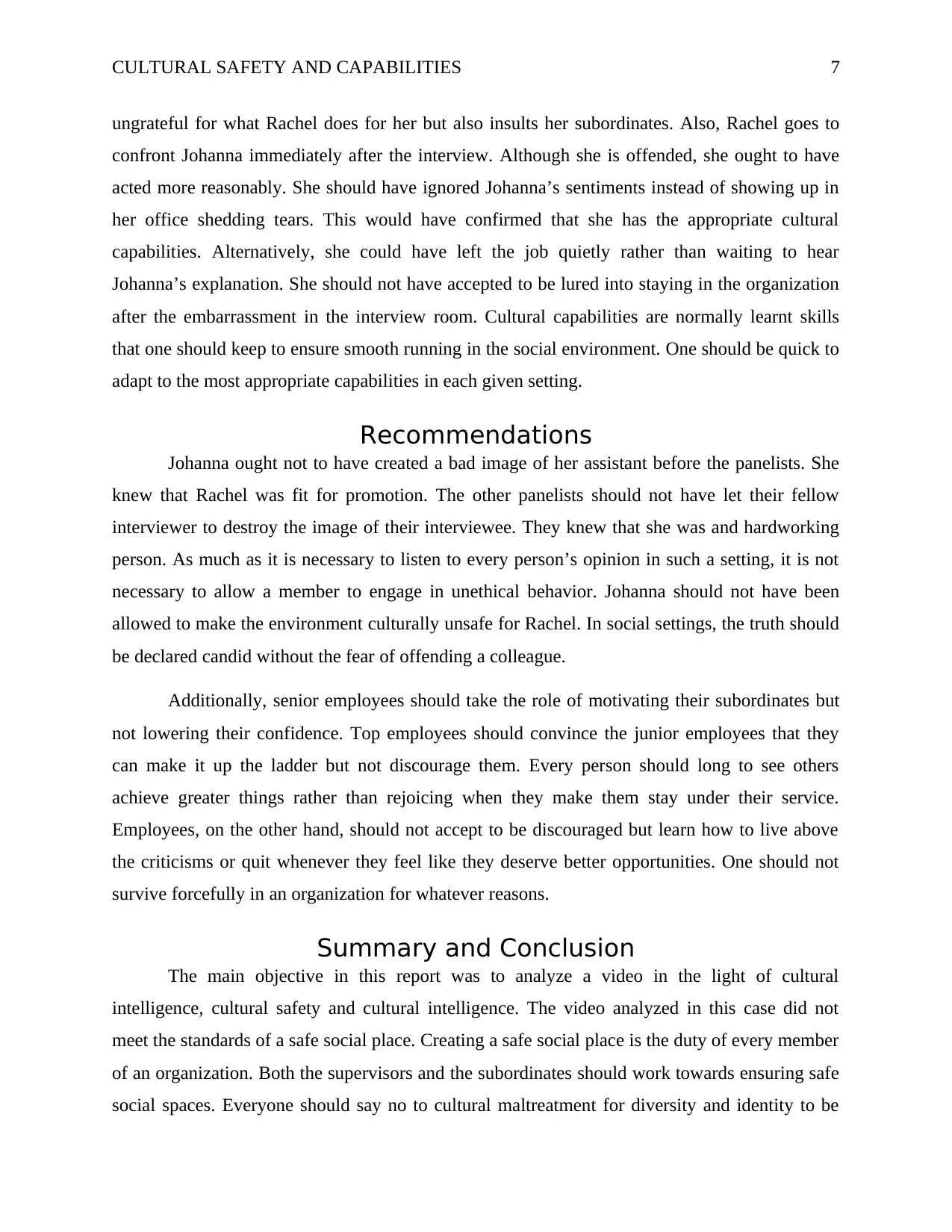
CULTURAL SAFETY AND CAPABILITIES 7
ungrateful for what Rachel does for her but also insults her subordinates. Also, Rachel goes to
confront Johanna immediately after the interview. Although she is offended, she ought to have
acted more reasonably. She should have ignored Johanna’s sentiments instead of showing up in
her office shedding tears. This would have confirmed that she has the appropriate cultural
capabilities. Alternatively, she could have left the job quietly rather than waiting to hear
Johanna’s explanation. She should not have accepted to be lured into staying in the organization
after the embarrassment in the interview room. Cultural capabilities are normally learnt skills
that one should keep to ensure smooth running in the social environment. One should be quick to
adapt to the most appropriate capabilities in each given setting.
Recommendations
Johanna ought not to have created a bad image of her assistant before the panelists. She
knew that Rachel was fit for promotion. The other panelists should not have let their fellow
interviewer to destroy the image of their interviewee. They knew that she was and hardworking
person. As much as it is necessary to listen to every person’s opinion in such a setting, it is not
necessary to allow a member to engage in unethical behavior. Johanna should not have been
allowed to make the environment culturally unsafe for Rachel. In social settings, the truth should
be declared candid without the fear of offending a colleague.
Additionally, senior employees should take the role of motivating their subordinates but
not lowering their confidence. Top employees should convince the junior employees that they
can make it up the ladder but not discourage them. Every person should long to see others
achieve greater things rather than rejoicing when they make them stay under their service.
Employees, on the other hand, should not accept to be discouraged but learn how to live above
the criticisms or quit whenever they feel like they deserve better opportunities. One should not
survive forcefully in an organization for whatever reasons.
Summary and Conclusion
The main objective in this report was to analyze a video in the light of cultural
intelligence, cultural safety and cultural intelligence. The video analyzed in this case did not
meet the standards of a safe social place. Creating a safe social place is the duty of every member
of an organization. Both the supervisors and the subordinates should work towards ensuring safe
social spaces. Everyone should say no to cultural maltreatment for diversity and identity to be
ungrateful for what Rachel does for her but also insults her subordinates. Also, Rachel goes to
confront Johanna immediately after the interview. Although she is offended, she ought to have
acted more reasonably. She should have ignored Johanna’s sentiments instead of showing up in
her office shedding tears. This would have confirmed that she has the appropriate cultural
capabilities. Alternatively, she could have left the job quietly rather than waiting to hear
Johanna’s explanation. She should not have accepted to be lured into staying in the organization
after the embarrassment in the interview room. Cultural capabilities are normally learnt skills
that one should keep to ensure smooth running in the social environment. One should be quick to
adapt to the most appropriate capabilities in each given setting.
Recommendations
Johanna ought not to have created a bad image of her assistant before the panelists. She
knew that Rachel was fit for promotion. The other panelists should not have let their fellow
interviewer to destroy the image of their interviewee. They knew that she was and hardworking
person. As much as it is necessary to listen to every person’s opinion in such a setting, it is not
necessary to allow a member to engage in unethical behavior. Johanna should not have been
allowed to make the environment culturally unsafe for Rachel. In social settings, the truth should
be declared candid without the fear of offending a colleague.
Additionally, senior employees should take the role of motivating their subordinates but
not lowering their confidence. Top employees should convince the junior employees that they
can make it up the ladder but not discourage them. Every person should long to see others
achieve greater things rather than rejoicing when they make them stay under their service.
Employees, on the other hand, should not accept to be discouraged but learn how to live above
the criticisms or quit whenever they feel like they deserve better opportunities. One should not
survive forcefully in an organization for whatever reasons.
Summary and Conclusion
The main objective in this report was to analyze a video in the light of cultural
intelligence, cultural safety and cultural intelligence. The video analyzed in this case did not
meet the standards of a safe social place. Creating a safe social place is the duty of every member
of an organization. Both the supervisors and the subordinates should work towards ensuring safe
social spaces. Everyone should say no to cultural maltreatment for diversity and identity to be
Paraphrase This Document
Need a fresh take? Get an instant paraphrase of this document with our AI Paraphraser
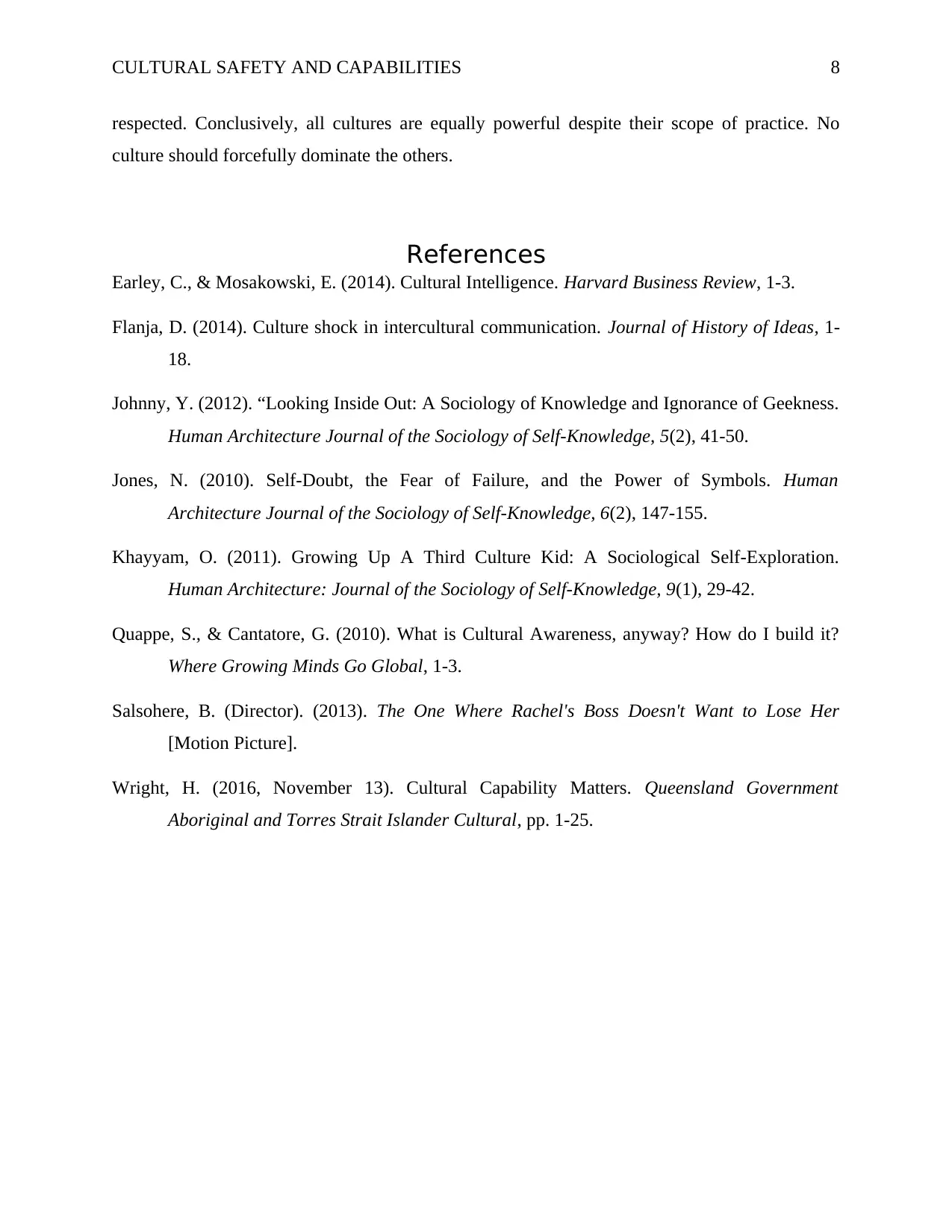
CULTURAL SAFETY AND CAPABILITIES 8
respected. Conclusively, all cultures are equally powerful despite their scope of practice. No
culture should forcefully dominate the others.
References
Earley, C., & Mosakowski, E. (2014). Cultural Intelligence. Harvard Business Review, 1-3.
Flanja, D. (2014). Culture shock in intercultural communication. Journal of History of Ideas, 1-
18.
Johnny, Y. (2012). “Looking Inside Out: A Sociology of Knowledge and Ignorance of Geekness.
Human Architecture Journal of the Sociology of Self-Knowledge, 5(2), 41-50.
Jones, N. (2010). Self-Doubt, the Fear of Failure, and the Power of Symbols. Human
Architecture Journal of the Sociology of Self-Knowledge, 6(2), 147-155.
Khayyam, O. (2011). Growing Up A Third Culture Kid: A Sociological Self-Exploration.
Human Architecture: Journal of the Sociology of Self-Knowledge, 9(1), 29-42.
Quappe, S., & Cantatore, G. (2010). What is Cultural Awareness, anyway? How do I build it?
Where Growing Minds Go Global, 1-3.
Salsohere, B. (Director). (2013). The One Where Rachel's Boss Doesn't Want to Lose Her
[Motion Picture].
Wright, H. (2016, November 13). Cultural Capability Matters. Queensland Government
Aboriginal and Torres Strait Islander Cultural, pp. 1-25.
respected. Conclusively, all cultures are equally powerful despite their scope of practice. No
culture should forcefully dominate the others.
References
Earley, C., & Mosakowski, E. (2014). Cultural Intelligence. Harvard Business Review, 1-3.
Flanja, D. (2014). Culture shock in intercultural communication. Journal of History of Ideas, 1-
18.
Johnny, Y. (2012). “Looking Inside Out: A Sociology of Knowledge and Ignorance of Geekness.
Human Architecture Journal of the Sociology of Self-Knowledge, 5(2), 41-50.
Jones, N. (2010). Self-Doubt, the Fear of Failure, and the Power of Symbols. Human
Architecture Journal of the Sociology of Self-Knowledge, 6(2), 147-155.
Khayyam, O. (2011). Growing Up A Third Culture Kid: A Sociological Self-Exploration.
Human Architecture: Journal of the Sociology of Self-Knowledge, 9(1), 29-42.
Quappe, S., & Cantatore, G. (2010). What is Cultural Awareness, anyway? How do I build it?
Where Growing Minds Go Global, 1-3.
Salsohere, B. (Director). (2013). The One Where Rachel's Boss Doesn't Want to Lose Her
[Motion Picture].
Wright, H. (2016, November 13). Cultural Capability Matters. Queensland Government
Aboriginal and Torres Strait Islander Cultural, pp. 1-25.
1 out of 8
Related Documents
Your All-in-One AI-Powered Toolkit for Academic Success.
+13062052269
info@desklib.com
Available 24*7 on WhatsApp / Email
![[object Object]](/_next/static/media/star-bottom.7253800d.svg)
Unlock your academic potential
Copyright © 2020–2025 A2Z Services. All Rights Reserved. Developed and managed by ZUCOL.





